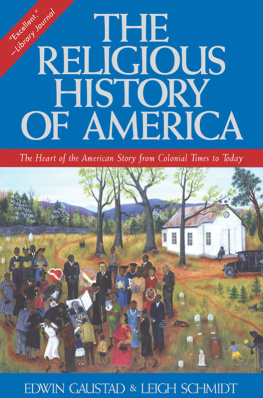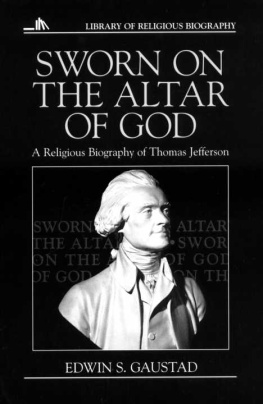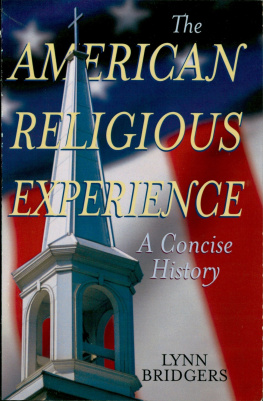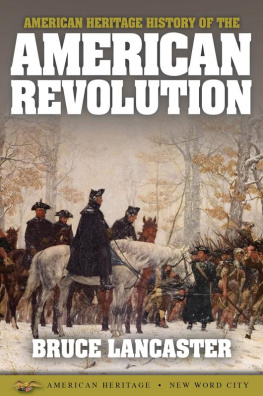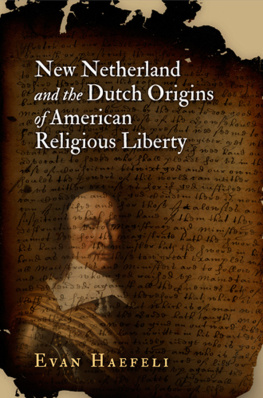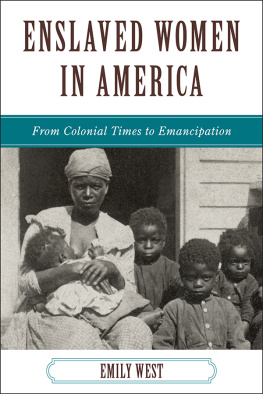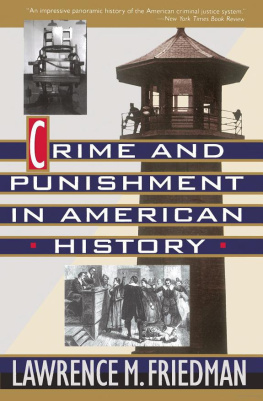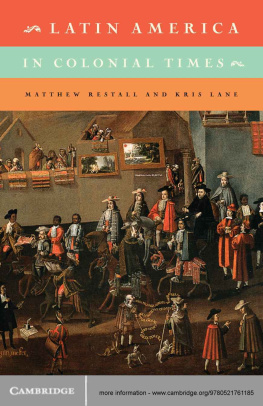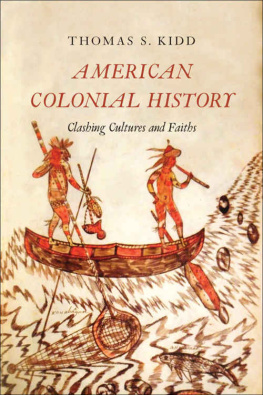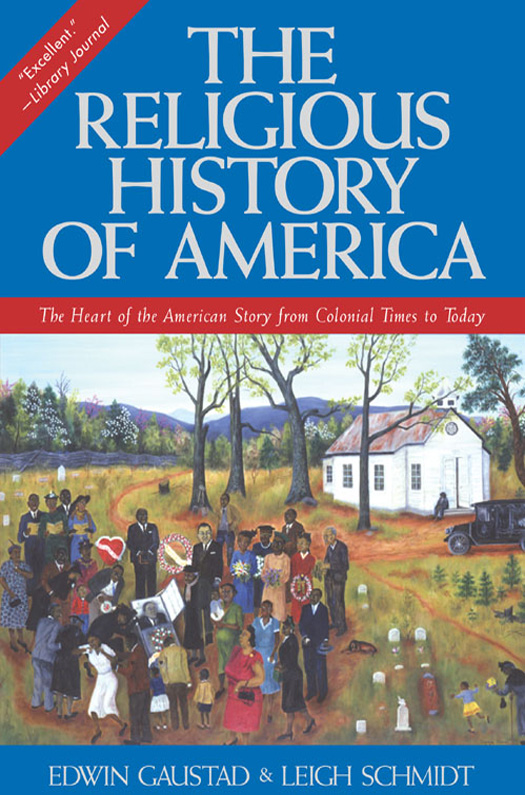Contents
Guide
Australia
HarperCollins Publishers Australia Pty. Ltd.
Level 13, 201 Elizabeth Street
Sydney, NSW 2000, Australia
www.harpercollins.com.au
Canada
HarperCollins Canada
2 Bloor Street East - 20th Floor
Toronto, ON M4W 1A8, Canada
www.harpercollins.ca
New Zealand
HarperCollins Publishers New Zealand
Unit D1, 63 Apollo Drive
Rosedale 0632
Auckland, New Zealand
www.harpercollins.co.nz
United Kingdom
HarperCollins Publishers Ltd.
1 London Bridge Street
London SE1 9GF, UK
www.harpercollins.co.uk
United States
HarperCollins Publishers Inc.
195 Broadway
New York, NY 10007
www.harpercollins.com
With great gratitude and boundless love,
we dedicate this book to our respective families.
Edwin Scott Gaustads A Religious History of America first appeared in 1966, taking its place as a prime successor to the leading text of the previous generation, William Warren Sweets The Story of Religion in America. Through subsequent revision and elaboration, Gaustads history has remained a standard introduction to the field for more than a quarter of a century. With this new edition, the hope is to make that distinguished narrative available to another generation of readers.
Such accessibility required more than simply reissuing the last edition. Given the swirl of changes in American religion and culture over the last decade and more, the text obviously needed updating. To start, that entailed substantially augmenting and reworking the final section on the period from World War II to the new millennium. Also, given the rapidly shifting and expanding scholarship dedicated to making sense of American religious history, all the bibliographies required renovation. On a larger scale, the organizational design of the narrative itself warranted some restructuring. In the place of the five distinct agesfrom the Age of Exploration to the Age of Limitsthat patterned the story before, the current incarnation places more explicit emphasis on specific historical markers. In an era that resists the grand narrative and the panoramic vision and that embraces fragmentation and dispersion, the Age of this or that has a noticeably discordant ring. In keeping with recent revisionist concerns, cultural encounter and religious conflict have been accented; also, added attention has been given to religious practices, visual materials, pluralism, and spiritual seeking.
The main intent of the book as well as the bulk of the narrative remain faithful to Gaustads original design, namely, to offer a wide-ranging sketch of the variable shapes and the diverse powers of religion throughout American history. Though this new edition necessarily introduces some of the rougher edges of more recent scholarship about American religious life, I hope that much of the old storytelling polish of the earlier editions remain. I also trust that much of Gaustads hopefulness about the American experimentthe working out of religious freedom, pluralistic dialogue, and national communityhas survived my own editing and rewriting.
This history remains, above all, Gaustads story, but he now has been brave enough to allow the voice of one of his own students into the text alongside his own. I have long been interested in the double-voiced talents of ventriloquists, and this new edition is perhaps worthy of such a tricky enterprise as containing two authorial voices in the body of one text. But of course the success of this exhibition is to be measured not by the harmony of those two voices but by the range of religious voices it makes audible.
Daniel Sack and James Hudnut-Beumler of the Material History of American Religion project deserve thanks for their interest in the visual dimensions of this project. The book is richer in appearance and interpretive detail because of that support. Acknowledgment and thanks are extended as well to Jennifer Wiley Legath and David Passiak for the time they spent as research assistants and sounding boards. Stephen W. Hanselman, John Loudon, Kris Ashley, and Priscilla Stuckey at Harper San Francisco improved and eased the production of this new edition in countless ways.
Leigh Eric Schmidt Princeton,
New Jersey
Summer 2001
Im tired of all these pilgrims, these puritans, these thieves. So sings the pop artist Jewel on her compact disc Spirit. It is a fatigue that historians of American religion know well, finding it not just among their students but also among themselves. Long gone are the days when New England Puritanism stood as the dominant emblem of Americas religious past, let alone its present. Stories of Pilgrim landings and first Thanksgivings now leave a syrupy taste, while any reexamination of witchcraft crises, religious persecutions, and Indian slaughters only replaces the yawn of those grown tired of Pilgrims and Puritans with a look of horror and disgust.
Plymouth Rock itself now seems not so much a relic of holinessthe consecrated place on which the Pilgrim forefathers landed, the great ancestral altar of libertyas a quaint artifact, a tourist curiosity, perhaps more befitting a minivan side trip (the Plymouth Voyager) than the Mayflower Compact. Long fenced in to protect it from being chipped away by souvenir seekers, Plymouth Rock sits now as a half-hallowed shrine that bears witness to the very invention and historical malleability of these Pilgrim forefathers. Throughout the nineteenth century and into the twentieth, much of the magical power of the rock came from the desire of many Americans to identify themselves closely with these Pilgrims and Puritans, to cherish them in all their piety and courage as the forefathers of the nation. Standing on this rock, as one lover of the Pilgrims wrote in 1832, ushers us into the presence of our fathers. But, what happens now in the twenty-first century when so many have grown weary of Pilgrims and Puritans, when so many find Anglo-American relations with Indians to be thievish or worse, when so few in this polyglot and multiracial nation identify with them as fathers, let alone as mothers? Where should a religious history of America begin when the old New England stories of origin now seem so contrived, so narrow, so political?
Stories told about historical beginnings remain especially significant, and it is important to recognize at the outset that there are multiple birth narratives in American religious history, just as there are for the making of the nation as a political entity. Many of these stories, though certainly not all, will be found in these pages. Among them, for example, is the prominence of Alaska as the eighteenth-century birthplace of Russian Orthodox Christianity in America. As one twentieth-century Orthodox Christian recalled, Alaska is for Orthodox Christians the oldest part of Orthodox America and the source of their spiritual roots in this land. Other groups tell other stories of their religious roots in Americathe organization of the first Jewish synagogue in 1729 in New York City; the formation of the first independent African church in the early 1770s, a Baptist congregation in Silver Bluff, South Carolina; or the emergence of the Christian restorationist movement in 1801 out of a giant revival meeting at Cane Ridge, Kentucky, a location recurrently celebrated as the birthplace of a faith. Then there are Roman Catholic claims about American beginnings, many of which center on St. Augustine, Florida, settled already with Spanish adventurers and Catholic missionaries in 1565. St. Augustine was founded forty-two years before the English colony at Jamestown, Virginia, and fifty-five years before the Pilgrims landed on Plymouth Rock in Massachusetts, boasted a recent partisan, making it the oldest permanent European settlement on the North American continent.

